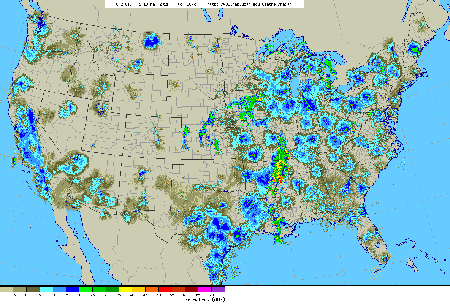
Common Loon
Credit: Jeff Wells
I glanced up while in our driveway in Gardiner Friday morning to see the black outstretched heads and sparkling white bellies of five high-flying Common Loons heading north as part of the immense wave of migrants that passed over the eastern U.S. Thursday night and in the early morning hours. Migration is at its peak across the U.S. and southern Canada as the estimated 1-3 billion birds that breed in the Boreal Forest make their way back home for the summer. Given that the spring migration period stretches over roughly one hundred days, that means that on average there would have to be somewhere between ten and thirty million birds a night (most birds migrate at night) that must pass north over the U.S.-Canada border. And given that more of the birds migrate in the later part of the season (May especially), that means that probably some nights there are many more tens of millions of songbirds filling our skies as we sleep in our beds.
Here is a radar image of bird migration from last night and you can read more about following bird migration with radar here:
Click on the image to enlarge.
Here in Maine where I live our neighborhood was flooded Friday morning with singing Yellow-rumped Warblers, Northern Parulas, and Nashville Warblers plus a sprinkling of Magnolia, Yellow, Black-and-white, and Black-throated Green warblers. The last few weeks we have seen streams of boreal breeding birds coming through Maine and the rest of the eastern U.S. including Ruby-crowned Kinglets, Palm Warblers, White-throated Sparrows, and White-crowned Sparrows. Last week we even had a Common Loon stop off from migrating to forage for food in the little stream that flows right through the downtown of our little town. These are all species that breed in great abundance in Canada’s Boreal Forest and there is a good chance that here in Maine these migrants, even including the Common Loons, are headed north to Quebec’s Boreal Forest.

White-crowned Sparrow
Credit: Jeff Wells
Little did they know that while they were working so hard to find their way back, Premier Charest of Quebec announced on Monday the formal proposed legislation for the so-called Plan Nord. A major component of this 25-year plan is to make an area of Quebec’s Boreal Forest the size of France, off-limits to industrial development ensuring that generations of Common Loons and White-crowned Sparrows and Yellow Warblers and Northern Parulas and billions more birds will forever brighten our spring days as they migrate through the landscape. Here are some of the media stories that came out about Monday’s Plan Nord announcement:
Here are some videos of some of the migrant Boreal birds that I have recorded over the last week or so here in Maine:
White-crowned Sparrow:
Common Loon:
Yellow Warbler:
Northern Parula:


